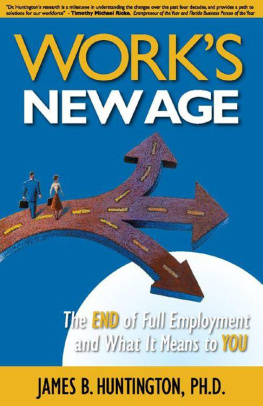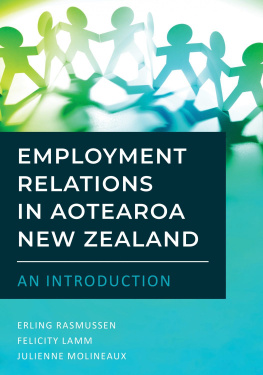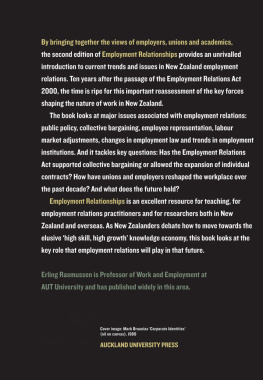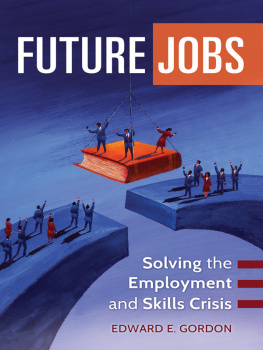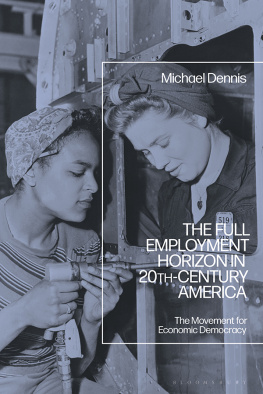WORKS
NEW AGE
The End of Full Employment
and
What It Means to You
WORKS
NEW AGE
The End of Full Employment
and
What It Means to You
James B. Huntington, Ph.D.

Royal Flush Press
Eldred, New York
Copyright 2012 by James B. Huntington
All rights reserved. No part of this book may be reproduced or transmitted in any form or by any means, electronic or mechanical, including photocopying, recording, or by any information storage and retrieval system, without written permission from the author, except for the inclusion of brief quotations in a review.
Royal Flush Press
P.O. Box 190
Eldred, NY 12732
orders@royalflushpress.com
www.royalflushpress.com
Edition ISBNs:
Softcover | 978-0-9835006-3-6 |
PDF | 978-0-9835006-4-3 |
Printed in the United States of America
Publishers Cataloging-in-Publication
(Provided by Quality Books, Inc.)
Huntington, James B.
Works new age: the end of full employment and what it means to you / James B. Huntington.
p. cm.
Includes bibliographical references and index.
LCCN 2011905514
ISBN-13: 978-0-9835006-3-6
ISBN-10: 0-9835006-3-0
ISBN-13: 978-0-9835006-4-3
ISBN-10: 0-9835006-4-9
1. Employment (Economic theory). 2. EconomicsUnited States. 3. United States--Economic conditions.
I. Title.
HD5701.5.H86 2011
331.12
QBI11-600107
To Mary, my old friend and new bride
Works New Age Principles
PRINCIPLE #1: Profitable and growing companies do not consistently add workers anymore.
PRINCIPLE #2: Major future inventions will have nowhere near the employment-boosting effect as cars, electricity, or television did in the past, as their work processes will be far too automated.
PRINCIPLE #3: Automation and scalability each damage the connection between work and consumption; their combination destroys it.
PRINCIPLE #4: Efficiencies discovered during bad times carry on to good times.
PRINCIPLE #5: Since adoption of retirement at age 65, American life expectancy has increased so much that if indexed in the same way now, retirement would be at age 98.
PRINCIPLE #6: Job ads no longer mean job hiring.
PRINCIPLE #7: America now has excess capacityin workers.
PRINCIPLE #8: Younger people, especially those under 20, have become less and less likely to work at all.
PRINCIPLE #9: From the point of view of customers, trading one product for another is the same as taking the resources needed for the first and making the second with them instead.
PRINCIPLE #10: If American workers are too expensive on the world market, then comparative advantage theory says America should produce fewer workers.
PRINCIPLE #11: If ten million people go into business and half lose money, then only five million had the equivalent of jobs.
PRINCIPLE #12: Although America has no universal health care, its government all by itself paid more per person than those of eight other developed countries with coverage for all.
PRINCIPLE #13: In order for markets to work, people must have money to spend.
PRINCIPLE #14: One person earning $5 million per year does not spend as much on goods and services as 100 people earning $50,000 apiece.
PRINCIPLE #15: Factory jobs replaced farm jobs. Service jobs replaced factory jobs. No paid work that we know of now will replace service jobs.
Table of Contents
Table of Figures
Acknowledgments
Chris DiNatale of DiNatale Design (www.dinataledesign.com) crafted and put the book cover together and designed the Royal Flush Press logo. Lars Clausen of American Author (www.americanauthor.com) provided the website and helped further with it. Editing and proofreading was by Mim Eisenberg of WordCraft (www.wordcraftservices.com), Jean Op-linger (jeanoplinger@gmail.com) completed the indexing, and Angela Werner (www.heyneon.com) designed and type-set the book. Printing was done by Color House Graphics (www.colorhousegraphics.com).
Thanks to Bill James for permission to reprint his passage on losing skills by not working.
Special thanks to those who came before me in perceiving the permanence of job losses, especially Jeremy Rifkin, Martin Ford, and Don Peck.
I thank my friends, relatives, and colleagues who served as an informal focus group on the book and provided other assistance: Sarah Chapin, Ping Chen, Jim Diederich, Diane Drey, Bill Evans, Ellen Faux, Sam Huntington, Skip Nelson, Mark Raphaelson, John Reitz, Tim Ricke, Diane Rozek, Jane Ann Scott, Sarah Yannett, Skip Yarian, and of course Mary.
Introduction: A Shift for the Ages
We must dare to prepare ourselves for the Exodus from work-based society: It no longer exists and will not return.
Andre Gorz
Many of us have had the idea, in the back of our minds, that the number of people who want work will always roughly approximate the number of people needed for it. Classical economics assumes that free markets will always have many jobs. Accordingly, when unemployment increases, it is due to bad times and will recover along with the economy. We have good reason to think that, because it has been correct since widespread work as we know it started with the Industrial Revolution. But, as the mutual funds always caution us, past performance does not guarantee future results.
This lifelong assumption we have is not true anymore. This is Works New Age.
So what is the problem, how do we know it is permanent this time, and how can we solve it? This book seeks to answer those questions.
Part I: The Problem
Chapter 1
Full Employments End: Now and So Far
Those who think some kind of robust recovery is hiding around the corner, just waiting to spring a pleasant surprise on us, are deluded.
Bob Herbert
On the Road to Works New Age
Once upon a time, there was no unemployment. At least nobody called it that. Why? Because there were few jobs as we understand them today. As of 1800, about two-thirds of what would now be called working-class people had no steady income and survived through day labor, begging, and crime.
Before World War I, people without jobs were referred to as idlers or loafers instead of unemployed, as the latter suggested that people could be out of work because of others choices.among American economic disasters, informed all of two things: The economy was interconnected, so the problems of people who lost their savings were not going to be limited to them, and even in the industrial world, there could be problems that would slash the number of jobs.
The country did not regain true prosperity before World War II, which filled up employment inside and outside the armed services. Afterwards, the greatest time of American affluence took hold. I call that era the Winning by Default Years, since after that devastating conflict, the United States economy had no real competition. Economist Tyler Cowen in The Great Stagnation, describing Americas pre-1975 ability to take advantage of relatively easy opportunities, had a similar idea. As the baby boom generation started reaching working age, the country stayed out of recession, allowing it to absorb large gains in the labor force. Times were good, and expectations were high.

